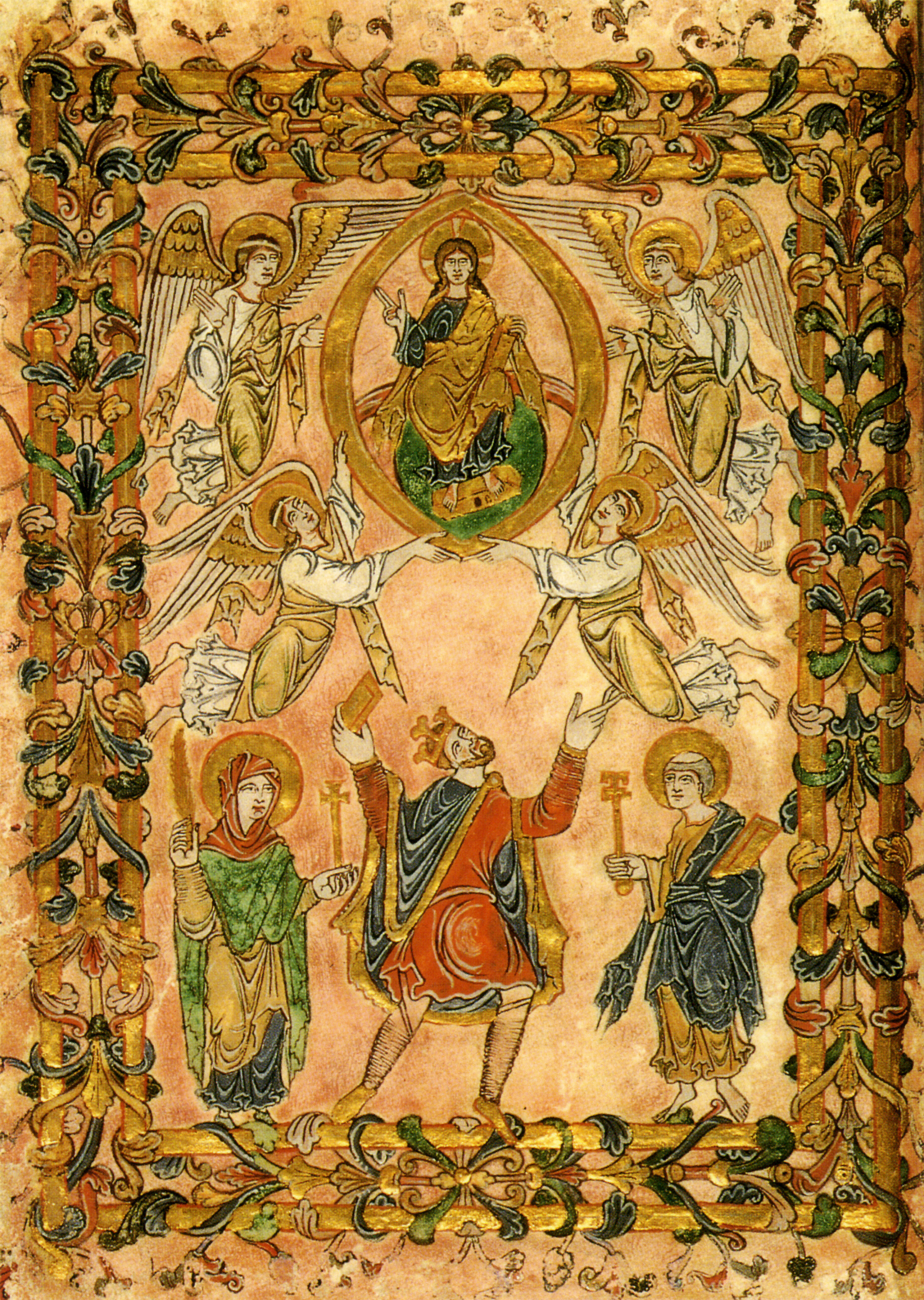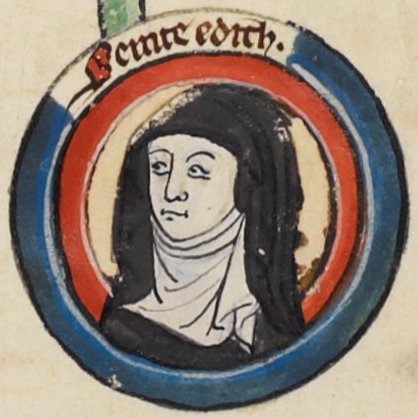by Susan Flantzer © Unofficial Royalty 2019

From the Illuminated manuscript of The Charter of Edgar to the New Minster, Winchester, 966; Credit – Wikipedia
The reign of Edgar the Peaceful, King of the English brought a period of peace unknown in recent memory. His coronation service written by St. Dunstan, Archbishop of Canterbury has formed the basis for the coronation services for English and British monarchs ever since. Born around 943, Edgar the Peaceful, King of the English was the younger son of the two sons Edmund I, King of the English and Ælfgifu of Shaftesbury. He had one elder brother:
- Eadwig, King of England (circa 940 – 959), married Ælfgifu, marriage annulled, no children
On May 26, 946, Edgar’s father King Edmund I was murdered while celebrating the feast of St. Augustine of Canterbury at a royal hunting lodge in Pucklechurch, north of Bath, England. Because Edmund’s two sons were very young, he was succeeded by his 23-year-old brother Eadred. When King Eadred died on November 25, 955, his successor was his nephew, Edgar’s 15-year-old elder brother Eadwig.
Eadwig was an unpopular king and his short reign was marked by conflicts with the nobility and the church. In 957, the Mercians and Northumbrians revolted and chose Edgar as king of the country north of the River Thames. The south of England, however, remained loyal to Eadwig. On October 1, 959, Eadwig died in Gloucester in what some consider suspicious, but certainly unknown circumstances, at around the age of nineteen. As Eadwig did not have children, his 16-year-old brother Edgar succeeded him and reunified England.
Edgar’s marriage history is uncertain. He had relationships with three women but only the third was considered his “lawful wife.
(1) Æthelflæd was the mother of Edgar’s eldest child Edward the Martyr, King of the English who was born around 962. Some sources say that Æthelflæd was a nun at Wilton Abbey, a Benedictine abbey in Wiltshire, England whom Edgar seduced. It is unclear whether Æthelflæd and Edgar married.
- Edward the Martyr, King of the English (circa 962 – 978), unmarried, murdered
(2) Saint Wulfthryth was a noblewoman who may have been abducted from Wilton Abbey by Edgar. She gave birth to a daughter Edith around 963. Bride abduction was a traditional part of Anglo-Saxon society but whether Edgar took Wulfthryth by force is not known. She did stay with Edgar for at least a year. It is uncertain whether Edgar married Wulfthryth. Eventually, Wulfthryth and Edith returned to Wilton Abbey where Wulfthryth later became the Abbess, and Edith became a nun. Dunstan, Archbishop of Canterbury made Edgar do penance for the crime of abduction by not wearing his crown for seven years. Edgar and Wulfthryth remained on good terms and Edgar gave financial support to Wilton Abbey for the rest of his life.

Edgar’s daughter Edith; Credit – Wikipedia
Edgar’s daughter Edith died on September 15, 984, at around the age of 21, and was buried in the church at Wilton Abbey. Wulfthryth survived her daughter, dying on September 21, 1000. She was buried before the main altar of the Wilton Abbey church. Both Wulfthryth and Edith were regarded as saints locally in Wiltshire after their deaths.

Ruins of the Wilton Abbey church where Wulfthryth and Edith were buried; Credit – Wikipedia
(3) In 964 or 965, Edgar married Ælfthryth, daughter of Ealdorman Ordgar of Devon. She was the first wife of a king known to have been crowned and anointed as Queen of the Kingdom of England. It is probable that Ælfthryth was linked to the murder of her stepson King Edward the Martyr so that her son Æthelred could become king. Around 986, she founded Wherwell Abbey, a Benedictine convent in Hampshire, England where she retired to live her last years. She died there on November 17 in 1000 or 1001.
Edgar and Ælfthryth had two sons:
- Edmund (circa 966 – 970 or 971), died in early childhood
- Æthelred II the Unready, King of the English (circa 968 – 1016), married (1) Ælfgifu of York, had at least eleven children including Edmund II Ironside, King of the English (2) Emma of Normandy, had three children including Edward the Confessor, King of England

Edgar between St. Athelwald, Bishop of Winchester and St. Dunstan, Archbishop of Canterbury; Credit – Wikipedia
Because of conflicts, Eadwig, Edgar’s brother, had banished Dunstan, then Abbot of Glastonbury. Upon becoming king, Edgar recalled Dunstan and created him Bishop of Worcester and the Bishop of London. In 959, Dunstan became Archbishop of Canterbury. He remained Edgar’s chief advisor throughout his reign. Dunstan oversaw reform in the English church. Order was maintained throughout the kingdom and there was respect for the law. A military force patrolled the north and a navy guarded the shores against Viking raids. There was a level of peace in the kingdom unknown for many years.
Although Edgar probably had a coronation at Kingston-on-Thames, the traditional site for Wessex coronations, Dunstan felt there was a need for a major ceremony similar to the coronations of the King of the Franks and the German Emperor. This coronation was delayed for some time as Dunstan was disturbed by Edgar’s personal life and he counseled Edgar as he changed his ways. Dunstan wrote the order of service for Edgar’s coronation based upon ceremonies used by the Kings of the Franks and ceremonies used in the ordination of bishops. The main elements of the British coronation service and the form of the oath taken by the sovereign can be traced to the order of service devised by Dunstan for Edgar’s coronation. Although there have been revisions in the order of the ceremony, the sequence of taking an oath, anointing, investing of regalia, crowning, and enthronement found in the Anglo-Saxon text have remained constant.
The coronation took place at Bath Abbey in Bath, England on May 11, 873. Edgar’s wife Ælfthryth was also crowned and anointed, giving her a status higher than any recent queen. Shortly after the coronation, Edgar held a council in Chester, England. Several Scots and Welsh kings attended and pledged their allegiance to Edgar, including Kenneth II of Scotland, Máel Coluim I of Strathclyde and his father Dyfnwal III, Maccus Haroldson of the Isle of Man and Hebrides, Iago ap Idwal of Gwynedd, Iago’s brother Idwal Fychan and his nephew Hywel ap Ieuaf. Supposedly, these kings rowed Edgar over the River Dee in a boat as a sign of their submission.

A Victorian representation of Edgar being rowed on the River Dee; Credit – Wikipedia
Edgar died on July 8, 975 in Winchester, England, aged 31-32, and was buried at Glastonbury Abbey in Somerset, England. In 1052, Edgar’s remains were moved within Glastonbury Abbey to a new shrine near the high altar. The shrine was lost when the abbey was left in ruins during the sixteenth century. Edgar was succeeded by his son Edward the Martyr.

Ruins of Glastonbury Abbey; Credit – By Pam Brophy, CC BY-SA 2.0, https://commons.wikimedia.org/w/index.php?curid=9115142
England: House of Wessex Resources at Unofficial Royalty
- Unofficial Royalty: House of Wessex Index
- Unofficial Royalty: British Royal Burial Sites: House of Wessex
- Unofficial Royalty: Coronations before the Norman Conquest (871 – 1066)
Works Cited
- Ashley, M. (1998). The Mammoth Book of British Kings & Queens. New York: Carroll & Graf Pub.
- Cannon, J. and Griffiths, R. (1988). The Oxford Illustrated History of the British Monarchy. Oxford: Oxford University Press.
- De.wikipedia.org. (2019). Edgar (England). [online] Available at: https://de.wikipedia.org/wiki/Edgar_(England) [Accessed 20 Feb. 2019].
- Dodson, A. (2004). The Royal Tombs of Great Britain. London: Duckworth.
- En.wikipedia.org. (2019). Edgar the Peaceful. [online] Available at: https://en.wikipedia.org/wiki/Edgar_the_Peaceful [Accessed 20 Feb. 2019].
- Williamson, D. (1998). Brewer’s British Royalty. London: Cassell.
This article is the intellectual property of Unofficial Royalty and is NOT TO BE COPIED, EDITED, OR POSTED IN ANY FORM ON ANOTHER WEBSITE under any circumstances. It is permissible to use a link that directs to Unofficial Royalty.
